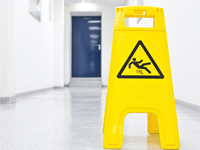
Students slip, trip, fall or collide and, while many will walk or run away with just a bruise or a scratch, last year 32,700 people in schools suffered injuries from falls serious enough to warrant an ACC claim.
Accidents happen, and no amount of cotton wool will prevent them all. However, schools can take a number of simple steps to prevent falls and to reduce the severity of the injuries that result from them.
In some cases, it’s as simple as flicking a switch.
“Make sure stairs are well lit, and if they’re not, then flick on the light switch,” says ACC communications manager Fiona Robinson. “Steps leading up to classrooms should be clear of hazards like wet leaves or clutter that children could slip or trip on.
You can also paint step edges for greater visibility, and encourage students to take their time on all steps or stairs.”
Other simple but effective considerations for indoor spaces include encouraging walking for inside and running for outside, wiping up spills straight away, and keeping classroom floors clear of obstacles such as loose rugs, equipment and toys.
“Electrical cords can also trip you up, so place and plug in electric heaters, computers and so on near to the socket,” Robinson says.
Another important consideration, especially when building a new space or renovating, is the choice of flooring materials.
Hamish Morrison of Floorspace Ltd says it’s important that schools look for performance and optimise the balance of quality and budget.
“The school is usually spending a lot anyway, so it’s often worth spending that little bit more to have peace of mind,” he says.
In wet areas such as toilets, locker rooms and art areas within classrooms, Morrison says, the practical choice is vinyl, which basically comes down to two categories – dry-slip or wet-slip rated, safety vinyl. But that doesn’t mean vinyl is the universal solution for school floors.
“Don’t forget carpet is also generally highly non-slip, and gives better sound absorption,” he says.
In terms of selecting carpet for a high-traffic, hard-wearing environment like a school, carpets that won’t wear or fade with consistent heavy use, combined with an easy to clean nature are recommended.
That sort of durability is important, as everyone knows that a worn floor can be a very slippery floor. But what if it’s not time for your school to replace a surface, and you are just looking for a way to improve the safety of a slippery surface in a problem area?
Elesia Ogg of Andy Andersons Industrial Services says grip treatments, such as the company’s Grip Guard, are excellent for retrofitting. “We can help people with a floor they may have chosen expecting it to be safe, and found it to be slippery,” she says.
The treatment works on the existing pores in tile, concrete or stone to dramatically improve traction in the wet without changing the appearance of the floor or making the surface rough.
Maintaining the smoothness of the surface means that if a fall does occur, it will not cause grazes in the way that a treatment that creates a rough surface could. Also, unlike a mat, it cannot come loose and create a tripping hazard.
These treatments can be used indoors or out, on textured surfaces or smooth.
It was recently applied to an outdoor tiled area at Onehunga High School. Previously, the tiles, which had been sold to the school as suitable for outdoor use, had been very slippery in wet weather and needed to be covered with mats.
Leaves from the surrounding trees frequently clogged the mats, creating another slippery surface and a difficult clean up job.
By treating the tiles with Grip Guard instead, Ogg says, the school now has a safer surface that is easy to maintain.
“In the outdoors, you can spray with Wet and Forget or waterblast and it won’t damage the treatment,” she says. “It’s a permanent treatment and the only maintenance required is cleaning.”
While flooring and hard outdoor surfaces can make a considerable difference in terms of student safety, the most common cause of fall injuries reported to ACC last year was loss of balance. The most common time was between 12pm and 2pm. To help protect students losing their balance between these times, schools need to tackle the playground.
“Falls are the leading cause of injury in playgrounds, and the play surface is therefore one of the most important safety features,” says Robinson of ACC.
She says schools must regularly check the play surface, making sure it extends out well beyond each piece of equipment and is free of litter, leaves and other hazards that children could trip or slip on. “Also, make sure play equipment is well maintained and check for missing rails, steps, rungs or seats, and make sure children wear suitable shoes during play,” she advises.
A report from the ERO finds new teachers aren’t prepared to teach, citing poor initial…
Dr Sarah Aiono defends modern education practices against recent criticisms, outlining the evidence behind 21st…
The country's largest union has criticised the funding of charter schools, saying it diverts funds…
What does the ideal learning environment for the 21st century look like? In this Special Report,…
Is your current school management system still fit for purpose, or are you paying for…
Bullying contributes to poor wellbeing and absenteeism in New Zealand. Discover how you can address…
This website uses cookies.